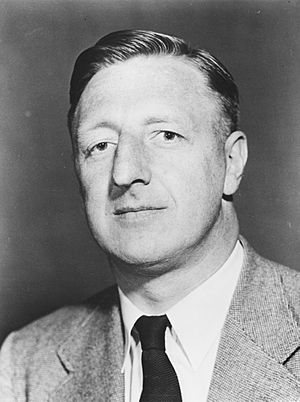Alan Walsh (physicist) facts for kids
Quick facts for kids
Sir Alan Walsh
FAA FRS
|
|
|---|---|
 |
|
| Born | 19 December 1916 Hoddlesden, England
|
| Died | 3 August 1998 (aged 81) |
| Alma mater | University of Manchester |
| Known for | Atomic absorption spectroscopy |
| Spouse(s) | Audrey Dale Hutchinson |
| Children | Thomas Haworth David Alan |
| Scientific career | |
| Institutions | BNF CSIR (later CSIRO) |
Sir Alan Walsh FAA FRS (19 December 1916 – 3 August 1998) was a brilliant British-Australian scientist. He is famous for inventing a special way to analyze chemicals called atomic absorption spectroscopy. This method helps scientists figure out exactly what elements are in different materials.
Contents
Biography
Alan Walsh was born on December 19, 1916. He grew up in Hoddlesden, a small village in England. His father, Thomas Haworth Walsh, was a cotton mill manager.
When he was ten, Alan went to the local grammar school in Darwen. He did very well in his exams. In 1935, he went to the University of Manchester to study physics. After graduating in 1938, he received a scholarship for research. He worked on the structure of a substance called β-carotene.
After a year, Walsh moved to London. He joined the physics section of the British Non-Ferrous Metals Research Association (BNF). He continued his research there and earned his Master of Science degree in 1944.
War Work and Discoveries
World War II started the day Alan joined BNF. His job was to find out what metals were used in enemy planes that had been shot down. This information helped understand how Germany's war efforts were progressing.
He created fast and accurate ways to analyze alloys. Alloys are mixtures of metals like aluminum, copper, or zinc. While working, he found that his method didn't always work the same in different labs. So, he designed a "General Purpose Source Unit." This unit helped create a steady and reliable source of light. This was very important for his work. He then helped a company called Hilger & Watts Ltd to make a commercial version of his invention.
Moving to Australia
In 1945, Alan applied for a job in Melbourne, Australia. He wanted to work for the Council for Scientific and Industrial Research (CSIR). He was offered the job in March 1946. First, he spent a few months in Cambridge, England. He learned about infrared molecular spectroscopy, a new field of study.
Walsh arrived in Australia in April 1947. He set up Australia's first working infrared spectrometer. This machine helps scientists study molecules. He soon realized it wasn't powerful enough for some molecules. So, he invented a "double-pass system" and patented it. A company called Perkin-Elmer used his design.
Atomic Absorption Spectroscopy
Alan Walsh is most famous for developing atomic absorption spectroscopy. This is a powerful tool for chemical analysis. It helps scientists identify and measure tiny amounts of elements in a sample. This method is now used all over the world in many fields, like medicine, environmental science, and mining.
In 1976, Walsh received a Royal Medal from the Royal Society. This award recognized his important work in spectroscopy and for inventing the atomic absorption method. He retired from CSIRO in 1977. In June of that year, he was made a Knight Bachelor, which means he was given the title "Sir." In 1982, he was invited back to CSIRO as a senior research fellow.
Honours, awards, affiliations and degrees
Medals and awards
- 1966 Britannica Australia Award
- 1969 Talanta Gold Medal
- 1969 Royal Society of Victoria Research Medal
- 1972 Maurice Hasler Award in Spectroscopy, Society for Applied Spectroscopy
- 1975 Kronland Medal, Czechoslavak Spectroscopic Society
- 1975 James Cook Medal, Royal Society of New South Wales
- 1976 Torbern Bergman Medal, Swedish Chemical Society
- 1976 Royal Medal, Royal Society
- 1977 Knight Bachelor
- 1978 John Scott Award, City of Philadelphia, USA
- 1980 Matthew Flinders Lecture and Medal, Australian Academy of Science
- 1982 Robert Boyle Medal, Royal Society of Chemistry (Inaugural Award)
- 1982 K.L. Sutherland Memorial Medal, Australian Academy of Technological Sciences (Inaugural Award)
- 1991 Colloquium Spectroscopicum Internationale Award for Major Scientific Contributions to Analytical Spectroscopy (Inaugural Award)
Academic affiliations
- 1958 Fellow, Australian Academy of Science
- 1969 Foreign Member, Royal Swedish Academy of Sciences
- 1969 Fellow, Royal Society
- 1969 Honorary Member, Society for Analytical Chemistry
- 1972 Honorary Fellow, Chemical Society
- 1975 Honorary Fellow, Royal Society of New Zealand
- 1979 Honorary Fellow, Australian Institute of Physics
- 1980 Honorary Fellow, Royal Society of Chemistry
- 1981 Honorary Member, Japan Society for Analytical Chemistry
- 1982 Fellow, Australian Academy of Technological Sciences
Honorary degrees
- 1970 DSc, Monash University
- 1986 DSc, University of Manchester
The Australian Institute of Physics has an award named after him. It's called the Alan Walsh Medal. It is given to Australian industrial physicists who have made important contributions to physics.
Family
After moving to Australia, Alan Walsh met Audrey Dale Hutchinson, a nurse. They got married in 1949. They had two sons, Thomas Haworth and David Alan.
Sir Alan Walsh passed away in Melbourne on August 3, 1998.

